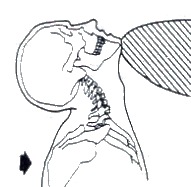
There are 3 major types of injury to the cervical spine.
The first two are intrinsically linked as both are caused by excessive bending, shear or axial displacements produced by indirect loading on the neck from relative displacements between the head and the torso. These types of neck injuries have their own specific problems.
The indirect loads can be generated by relative head to torso displacements which are produced by two main mechanisms.
The frontal head impact mechanism produces the most severe injuries due to the potentially higher indirect loads and a more varied direction of loading with the possibility of vertebrae and spine dislocation. The second, rear impact mechanism with neck. hyperextension, produces mainly soft tissue damage which, although not life threatening, can lead to long term disability.
In the first front loading mechanism, severe bending, fracturing and dislocations of the vertebrae impinges directly on to the spinal cord. In a minor loading case it can produce reversible and irreversible damage to individual nerves causing the person to loose sensory and motor control of specific parts of the body. At its worst, it can cause complete damage and dislocation of the spinal cord with the person losing total control of their entire body.
Unfortunately this is at its most severe at the upper cervical spine where severe fracturing and dislocation of the C1 and C2 vertebrae, severs the spinal cord where it forms the brainstem and, is usually fatal, with AIS 6. The severity of the injury reduces the lower down the cervical spine the dislocation takes place. So if the dislocation occurs below C5, control of the thorax and abdomen is maintained but sensory and motor control of all the limbs is lost, causing quadriplegia or paraplegia, AIS 5.
Minor fractures damage which do not impinge on the spinal cord, soft tissue, muscle and ligament, are not life threatening AIS 2-3, but can lead to long-term disability and discomfort.
In terms of injury mechanisms to the cervical spine these are nearly always due to indirect loading produced by relative translations and rotations between the head and the torso. The Figure 15 overleaf defines the significant loading directions with the injuries produced by specific loading types and combination of loading types. In the rail environment the majority of these indirect neck injuries will be produced by the head / face impacting a seat back or partition and the torso being decelerated through the neck, producing a complex combination of bending and axial forces. These forces being determined by the relative trajectories of the head and torso, angle of the impacting surface and/or impact location on the head or face. Figure 15 shows some examples of different loading situations and possible injuries which may be applicable to the rail environment.
The two major impact injury mechanisms being:
Any lateral bending or lateral rotation of the head immediately prior to impact of course can complicate both of these.
The only other common injury mechanisms is tension-extension where the torso is accelerated rapidly forwards and the head is accelerated via the neck producing hyperextension or ‘whiplash’ type injury as in rear facing seats with no or poorly designed head restraint. This is normally associated with soft tissue injury although the actual injuries that cause the long-term disability and discomfort are still unresolved.
|
A
|
B
 |
C
|
D
|
Figure 15 Shows Some Examples Of Different Loading Situations And Possible Injuries
A - Head extension with tension |
Unidirectional low seat back head impact on upper seat edge
B – Head axial impact |
Open bay head impact on to seat back/ standing/ exposed seating
C - Head Hyperextension |
Rear Impact with low seat back
The head and the torso usually protect the neck, so direct impacts to the front of the neck are relatively rare. However in the rail environment with low seat backs and standing occupants these potentially can occur. There is very little literature concerning such injuries both from blunt objects, which if severe can cause direct damage to the trachea, AIS 3, Larynx, AIS 2 - 4, and Oesophagus, AIS 3 and sharp objects which can cause severe lacerations and penetrating injuries to the Carotid artery, AIS 4-5. and jugular vein, AIS 3.

|
Dr. A.R. Payne |
S. Patel |
© MIRA 2001 |
|
Project 427519 |
Version 1.1 |